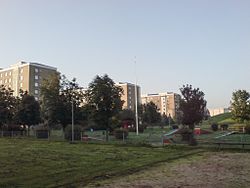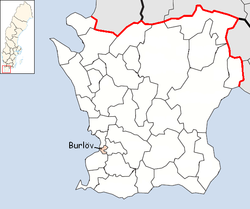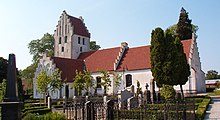Burlöv Municipality
Burlöv Municipality
Burlövs kommun | |
|---|---|
 | |
 | |
| Coordinates: 55°38′N 13°04′E / 55.633°N 13.067°E | |
| Country | |
| National Area | South Sweden |
| Province | |
| County | |
| Seat | Arlöv (part of Malmö) |
| Area | |
• Total | 19.2 km2 (7.4 sq mi) |
| • Land | 18.9 km2 (7.3 sq mi) |
| • Water | 0.3 km2 (0.1 sq mi) |
| Area as of 1 January 2014. | |
| Population (31 December 2023)[2] | |
• Total | 19,844 |
| • Density | 1,000/km2 (2,700/sq mi) |
| Time zone | UTC+1 (CET) |
| • Summer (DST) | UTC+2 (CEST) |
| ISO 3166 code | SE |
| Municipal code | 1231 |
| Website | www.burlov.se |
Burlöv Municipality (Swedish pronunciation: [ˈbʉ̌ːɭœv];[3] Burlövs kommun) is a municipality in Skåne County in South Sweden in southern Sweden, just north of Malmö. Its seat is located in Arlöv, a community which for geographical and statistical purposes is seen as a part of Malmö (Malmö tätort).
The municipality is one of only a few in Sweden, and the only one in Scania, which still contains only the original municipal entity created from the old parish in 1863 (cf history of municipalities in Sweden) and has not been amalgamated. It is the second smallest municipality by area in the whole country (after Sundbyberg Municipality).
Geography
[edit]The municipality has no forests, lakes, or streams, but has an abundance of high-voltage power grids, highways and railroads, as it is on the main line from Malmö to northern Sweden. Like the rest of Scania, much land is used for agriculture and there are several old farms, mills and other sights from the last centuries in the vicinity.
Urban areas
[edit]There are three urban areas (also called a tätort or locality) in Burlöv Municipality, including Arlöv, which statistically is a part of Malmö (*). Malmö is mostly located in Malmö Municipality but a part of it sprawls into Burlöv Municipality.
In the table they are listed according to the size of the population as of December 31, 2005. The municipal seat is in bold characters.
| # | Locality | Population |
|---|---|---|
| 1 | Malmö (part of*) | 9,108 |
| 2 | Åkarp | 5,393 |
| 3 | Burlövs egnahem | 523 |
Arlöv is an early industrialized town dominated by multi-storey apartment buildings, with a working class character. Its largest industry is Arlöv Sugar Factory, to which large amounts of sugar beets are transported from all around Scania.
Burlöv Center is located in Arlöv. It is a large shopping mall in the region.
Åkarp and Burlövs egnahem consist of detached house districts. They have a suburban character from where people commute to commercial centres and work within the metropolitan area of southwestern Scania.
Demographics
[edit]This is a demographic table based on Burlöv Municipality's electoral districts in the 2022 Swedish general election sourced from SVT's election platform, in turn taken from SCB official statistics.[4]
In total there were 19,713 residents, including 13,481 Swedish citizens of voting age.[4] 48.5% voted for the left coalition and 48.8% for the right coalition.
| Location | Residents | Citizen adults |
Left vote | Right vote | Employed | Swedish parents |
Foreign heritage |
Income SEK |
Degree |
|---|---|---|---|---|---|---|---|---|---|
| % | % | ||||||||
| Centrala Arlöv | 2,152 | 1,519 | 53.4 | 44.0 | 63 | 44 | 56 | 19,646 | 33 |
| Elisetorp V | 1,581 | 1,122 | 52.7 | 44.2 | 69 | 40 | 60 | 19,685 | 31 |
| Elisetorp Ö | 1,985 | 1,281 | 51.3 | 46.1 | 69 | 37 | 63 | 20,099 | 30 |
| Gamla Åkarp | 2,168 | 1,497 | 43.9 | 55.2 | 85 | 79 | 21 | 31,244 | 62 |
| Harakärrsområdet | 2,108 | 1,557 | 43.3 | 56.0 | 84 | 80 | 20 | 29,469 | 56 |
| Karstorp-Svanetorp | 2,118 | 1,513 | 43.0 | 56.2 | 85 | 82 | 18 | 30,369 | 53 |
| Kronetorp | 2,112 | 1,207 | 45.3 | 49.9 | 73 | 39 | 61 | 23,581 | 38 |
| Svenshög | 2,315 | 1,586 | 59.5 | 33.6 | 61 | 29 | 71 | 17,032 | 27 |
| Tågarp V | 1,731 | 1,223 | 47.1 | 50.4 | 76 | 53 | 47 | 25,526 | 35 |
| Tågarp Ö | 1,443 | 976 | 51.6 | 43.8 | 69 | 42 | 58 | 22,144 | 33 |
| Source: SVT[4] | |||||||||
Politics
[edit]Municipal politics has historically been dominated by the Social Democratic Party, but since the 2018 election a right-wing coalition led by the Moderate Party and supported by the Sweden Democrats has controlled the municipal government.[5]
Transport
[edit]The E6 and E22 highways meet in Burlöv, and share a route south towards Malmö. Burlöv is also located along the Southern Main Line, and is served by the Pågatågen commuter train system.
Demography
[edit]
The population of Burlöv Municipality increased with almost 1,000 people between 1986 and 2003. The largest part of the population increase has been due to high birth rates. Moving rates have played a small part, and is rather equalled, where – as is normal in smaller communities – young people move out and families with children move in.
Culture and history
[edit]Arlöv is located in the vicinity of agricultural fields, where the Old Church of Burlöv can be found, in the Burlöv Village. One of the oldest churches in Scania, it has mostly remained the way it was built in the 12th century, with its oldest parts concreted out of sandstone.
The coat of arms depict a sugar beet which was the chief industry for a while (e.g. the large Arlöv's Sugar Factory), and a star that symbolizes the Hvilan folk high school which was among the first group of folk high schools that were established in 1868.
International relations
[edit]The municipality is twinned with:[6]
 Anklam, Germany
Anklam, Germany
References
[edit]- ^ "Statistiska centralbyrån, Kommunarealer den 1 januari 2014" (in Swedish). Statistics Sweden. 2014-01-01. Archived from the original (Microsoft Excel) on 2016-09-27. Retrieved 2014-04-18.
- ^ "Folkmängd och befolkningsförändringar - Kvartal 4, 2023" (in Swedish). Statistics Sweden. February 22, 2024. Retrieved February 22, 2024.
- ^ Jöran Sahlgren; Gösta Bergman (1979). Svenska ortnamn med uttalsuppgifter (in Swedish). p. 6.
- ^ a b c "Valresultat 2022 för Burlöv i riksdagsvalet" (in Swedish). SVT. 11 September 2022. Retrieved 2 February 2024.
- ^ Karlsson, Johanna M (2018-12-18). "Nu är Burlövs nya högerstyre på plats". Sydsvenskan (in Swedish). Retrieved 2023-05-04.
- ^ "Burlovguiden.nu" (PDF). Archived from the original (PDF) on 2011-09-11. Retrieved 2010-01-19.
External links
[edit]- Official website
- Coat of arms
- Hvilan Folk High School In Swedish only.

